教师资格证初中英语面试真题集
教资英语面试试题及答案

教资英语面试试题及答案一、教学设计题1. 题目:如何教授初中英语中的一般现在时态?2. 要求:请设计一个教学方案,包括教学目标、教学方法、教学过程和评价方式。
答案:教学目标:- 学生能够理解一般现在时态的基本用法。
- 学生能够正确使用一般现在时态描述日常活动和习惯。
教学方法:- 利用多媒体教学,展示不同情境下的一般现在时态使用。
- 通过角色扮演和小组讨论,让学生实践时态的运用。
教学过程:1. 引入:通过播放一段视频,展示人们的日常活动,引导学生观察并讨论。
2. 讲解:教师详细解释一般现在时态的构成和用法。
3. 练习:学生完成一系列填空和转换句子的练习,巩固语法知识。
4. 应用:分组进行角色扮演,用一般现在时态描述自己的日常生活。
5. 评价:通过学生自评和互评,以及教师的反馈,评价学生的表现。
评价方式:- 观察学生在角色扮演中的语言表达能力。
- 检查学生的练习完成情况。
- 通过小测验来评估学生对一般现在时态的掌握程度。
二、案例分析题1. 题目:一位英语教师在课堂上使用游戏教学法,但发现学生对游戏不感兴趣,如何改进?2. 要求:分析原因并提出改进措施。
答案:原因分析:- 游戏可能与学生的实际生活或兴趣不符。
- 游戏规则可能过于复杂,学生难以理解。
- 游戏可能没有充分激发学生的参与热情。
改进措施:1. 了解学生的兴趣和需求,设计符合他们口味的游戏。
2. 简化游戏规则,确保学生能够快速上手。
3. 增加游戏的互动性和竞争性,提高学生的参与度。
4. 结合教学内容,确保游戏与学习目标紧密相关。
5. 定期收集学生反馈,根据反馈调整游戏内容。
三、教学反思题1. 题目:在一次英语教学中,你发现学生对某个语法点理解不透彻,你将如何进行教学反思?2. 要求:描述教学反思的过程和可能的改进方法。
答案:教学反思过程:1. 分析原因:回顾教学过程,找出学生理解不透彻的原因。
2. 收集反馈:向学生询问他们的困惑点,了解他们的学习障碍。
初中英语教师资格证面试真题11(语音)

中学教师资格证面试真题考点:初中英语1.题目:语音教学试讲2.内容:I have a pet cat.Her name is Pat.She gets a present from my dad.Is she happy about it?No, she was sad.3.基本要求:(1)朗读所给内容。
(2)配合教学内容适当板书。
(3)讲解元音的区别。
(4)用英文试讲。
(5)试讲时间:10分钟答辩题目1. In your opinion, how can junior high school students learn pronunciation well?2. How to cultivate students’sense of pronunciation?二、考题解析【教案】Teaching aims:Knowledge aim:Students can master the difference between the pronunciation of letter ‘e’and ‘a’. Ability aim:Students can use the pronunciation rules into daily communication.Emotional aim:Students can be more interested in learning English.Key and difficult point:Key Point:Students can master the difference between the pronunciation of letter ‘e’and ‘a’.Difficult Point: Students can use the pronunciation rules into daily communication.Teaching procedure:Step 1: Warming-up1. Greetings.2. Have a free talk with students talk about the present that they received before and their feelings about it.Step 2: Presentation1. Ask students to read the dialogue and pay attention to the underlined words in the conversation.2. Review the underlined word with students by invite some of the students to explain the meaning or imitate the words. And write it down on the black board respectively.3. Divide the words into two groups and ask students to find out the similar letter in each group4. Lead the students to find the rules of the pronunciation of letter ‘e’and letter ‘a’in the stressed close syllable. Conclude the difference between the two soundStep 3:Practice1. Read the words on the black board and lead students to repeat after the teacher.2. Read some words and let students to pick out the words where the pronunciation is ‘e’.fat set ratvet get patternStep4: Production1. Ask students to find more words that pronoun ‘/e/’and ‘/æ/’and divide them into two groups.2. Ask students to make a dialogue talk about their favourite gift and pay attention to the pronunciation of letter ‘e’and ‘a’.Step 5: Summary and HomeworkSummary: Ask a student to conclude the content of the lesson and summarize with the whole class.Homework: Ask students to find more pronunciation of letter ‘e’and letter ‘a’Blackboard design:Pronunciation【答辩题目解析】1. In your opinion, how can junior high school students learn pronunciation well?As for the students, they have learned English for several years, so they have accumulated some pronunciation knowledge, but they may be lacking in the differences of some similar sound, and they sometimes can’t distinguish the sound by themself. So it is very important for the teacher to lead them to the rules and let them to find the rules, which can both help them to improve the ability study on their own and master the knowledge the same time.In this way, students can learn pronunciation well.2.How to cultivate students’sense of pronunciation?It is one of the strategies of teaching listening to cultivate students’sense of pronunciation. Following are the methods. Firstly, students should listen to the tape to imitate the correct pronunciation. Secondly, students should pay more attention to the change of pronunciation in the process of communication. Thirdly, the listening materials should be authentic, just as in real-life listening.。
初中英语教师资格证面试真题9(词汇)
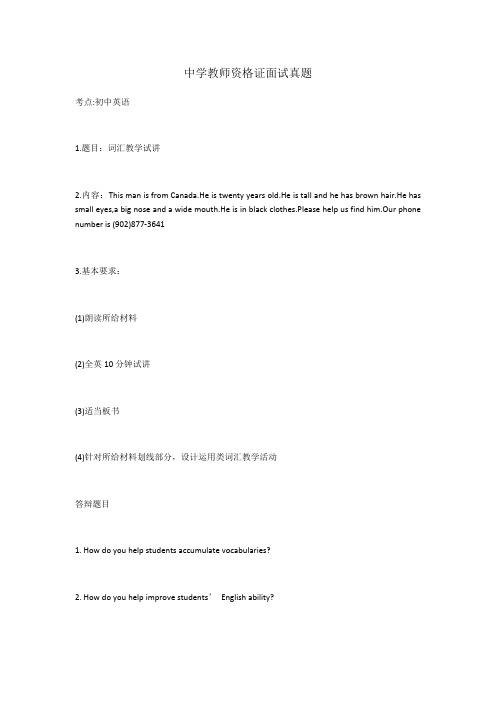
中学教师资格证面试真题考点:初中英语1.题目:词汇教学试讲2.内容:This man is from Canada.He is twenty years old.He is tall and he has brown hair.He has small eyes,a big nose and a wide mouth.He is in black clothes.Please help us find him.Our phone number is (902)877-36413.基本要求:(1)朗读所给材料(2)全英10分钟试讲(3)适当板书(4)针对所给材料划线部分,设计运用类词汇教学活动答辩题目1. How do you help students accumulate vocabularies?2. How do you help improve students’English ability?【教案】Teaching aims:Knowledge aim:Students will master the the meaning of the phrases, such as : small eyes, big nose and wide mouth and so on.Ability aim:Students will use the words to describe others in their daily life.Emotional aim:Students will be interested in learning English.Students will be more confident in speaking English.Key and difficult point:Key Point:Students will grasp the meaning of the new words.Students will use the words in their daily life and describe others.Difficult Point:Students will be interested in learning English and not afraid of speaking English in front of others.Students will be more confident in speaking English.Teaching procedure:Step 1: Warming-up1. Greetings. Talk about the weather.2. Sing a song Head, shoulder, knees and toesHead shoulders knees and toesKnees and toesHead shoulders knees and toesKnees and toesAnd eyes and ears and mouthAnd noseAsk the students if they are excited after this song, tell them there are some words about the parts of our body in this song. Then introduce today’s topic.Step 2: Presentation1. Draw some pictures of the new words on the blackboard.Introduce the words and explain the meaning with touching the parts of our body. Lead the students read the new words for twice or three times.New words: ear, eyes, nose, mouth hair2. Read the passage for the students, let them add the adjectives of the new words. Then the words change to phrases.Phrases:cute ear, small eyes,big nose, wide mouth brown hair3. Lead in the new sentence and explain the usage of it: he has...Step 3: Practice1. Play a game called “magic eyes”,when teacher touch the part of the body, students should react quickly and say the words.Then teacher will do the actions faster, students should say the words faster.2. Play a game “what’s missing”. Show some pictures of cartoon character and ask them “What’s missing”.( Doraemon has no ear, Hello kitty has no mouth )3. Teacher describe the students in the class, use the sentences “He has ...”, let the students guess who he/she is.Step4: Production1. Draw and guess. They need to work in pairs for the game. One student should draw the organs and present its feature. Then the other student should guess what he is drawing and read the words correctly. 3 pairs will be invited to play the game. The pair finishing the game with the shortest time is the winner.2. Role-play. Work in pairs. Student A and student B should describe each other. They need to make a presentation according to the given words. Invite one pair to make the presentation.Step5: Summary and HomeworkSummary: Make a brief summary of what we have learned with students.Homework: Draw the pictures and write down the according words, and hand it to the teacher tomorrow.Blackboard design:+Body【答辩题目解析】1.How do you help students accumulate vocabularies?First, these words can be introduced in a funny way, just like what I have done in the presentation part. This will deepen the memory of each word. Second, exercises must be conducted to consolidate the words. Then, after class, they should do some homework. Also, these words need to be review on a regular basis, so that they won’t forget them easily.2. How do you help improve students’English ability?First, interest must be aroused in learning English. Without passion in English, they will learn it passively and will not receive good result. So I will arrange different activities to attract their attention. Second, they need to learn knowledge step by step. So I will impart knowledge from input to output, namely, from presentation to practice and production. Output is essential, because a word can truly leave a deep impression on students when they use it. By doing this,they will absorb the knowledge gradually. So in my opinion, students can improve their English ability through the above two steps.。
(完整word版)教师资格证初中英语面试真题集
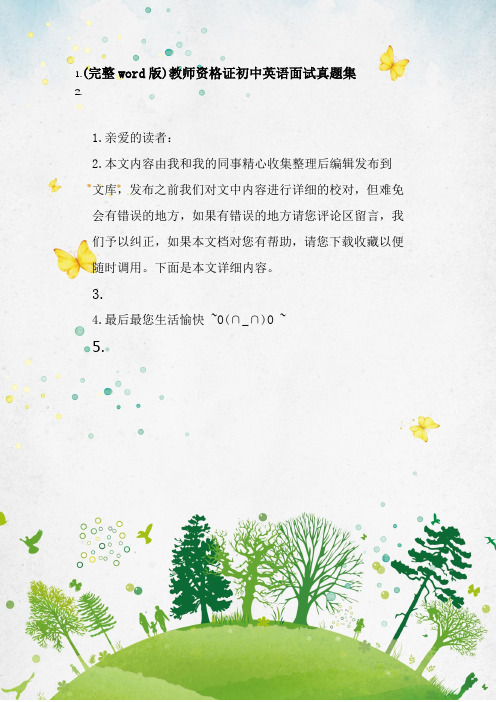
1.(完整word版)教师资格证初中英语面试真题集2.1.亲爱的读者:2.本文内容由我和我的同事精心收集整理后编辑发布到文库,发布之前我们对文中内容进行详细的校对,但难免会有错误的地方,如果有错误的地方请您评论区留言,我们予以纠正,如果本文档对您有帮助,请您下载收藏以便随时调用。
下面是本文详细内容。
3.4.最后最您生活愉快 ~O(∩_∩)O ~5.3.试讲题目:阅读教学试讲4.内容:Class 9 had a great time on the school trip. They went to Blue Water Aquarium for the day. First they visited the visitors center and watched about sharks. Then they watched a dolphin show. After that, they went to the outdoor Pool and saw a big octopus. After lunch, they went to the Gift Shop and bought lots of gifts. Finally, tired but happy, they took the bus back to school. At the end of the day, the science teacher was very happy because the class monitor cleaned the bus after the trip.3. 基本要求:(1)朗读所给段落。
(2)配合教学内容适当的板书。
(3)针对该段落中的划线部分,设计相应的阅读后教学活动。
(4)试讲时间:约10分钟。
(5)用英文试讲。
1.写作教学试讲2.内容:Dear Editor,I am writing to say that I am against building a new zoo in ourtown. Zoos are terrible places for animals to live. I’ve visited a lot of zoos in my life, and I have never seen one I liked or one that was suitable for animals to live in. Just last week, I visited a zoo and couldn’t believe what I saw. The animals are kept in tiny cages and can hardly move at all. And they are only given food once a day. Is this a good way for animals to live? I don’t think so.Sincerely,Disgusted 3 基本要求:(1)朗读所给短信。
初中英语教资面试题本

初中英语教资面试题本一、教学理念与方法英语教学在初中阶段起着至关重要的作用,既要培养学生的语言技能,又要激发学生学习英语的兴趣。
因此,我的教学理念是以学生为中心,注重培养学生的实际应用能力。
以下是我在面试中常被问到的问题:1.你认为初中英语教学应该注重培养学生的哪些基本技能?在初中英语教学中,我认为应该注重培养学生的听、说、读、写四项基本技能。
听和说是语言交流的基础,通过听力训练和口语练习,学生可以提高自己的听力理解和口语表达能力。
阅读和写作是学生进行深入学习和思考的重要手段,通过阅读和写作练习,学生可以拓宽自己的知识面,培养自己的思维能力和表达能力。
2.在英语教学中,你通常采用哪些教学方法?在英语教学中,我通常采用多种教学方法,根据学生的特点和英语教学的要求灵活运用。
例如,我会结合游戏教学法,通过游戏的形式激发学生学习的兴趣;我也会采用任务型教学法,给学生一些实际的任务,让他们在解决问题的过程中提高自己的语言能力。
此外,我还会借助多媒体教学手段,如投影仪、电脑等,使教学更加生动有趣。
二、课堂管理与布置良好的课堂管理是英语教学的重要环节,它影响着学生的学习效果和教学秩序。
面试中,我常被问到如何管理课堂和布置课堂。
1.你如何管理课堂,保持教学秩序?在管理课堂时,我会提前准备充足的教学内容,并制定详细的教学计划,确保教学进程的有序进行。
我会密切关注学生的学习情况,及时给予他们反馈和指导,并鼓励他们积极参与课堂讨论和活动。
同时,我也会制定一定的纪律规则,并在学生入班时向他们详细介绍,以维护课堂的秩序和学习的氛围。
2.你如何布置课堂,使其更具教学效果?为了使课堂更具教学效果,我会根据不同的教学内容和学习目标进行布置。
例如,如果是口语练习环节,我会采用圆桌式布局,让学生充分参与其中;如果是阅读理解环节,我会将学生分成小组,进行小组合作阅读。
同时,我也会注意课堂的装饰,使用一些与学习内容相关的图片和海报,营造良好的学习氛围。
教师资格考试初中面试英语试题与参考答案
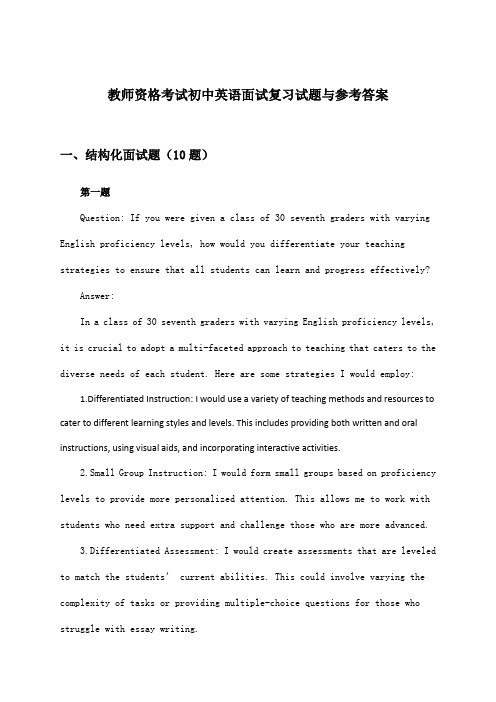
教师资格考试初中英语面试复习试题与参考答案一、结构化面试题(10题)第一题Question: If you were given a class of 30 seventh graders with varying English proficiency levels, how would you differentiate your teaching strategies to ensure that all students can learn and progress effectively?Answer:In a class of 30 seventh graders with varying English proficiency levels, it is crucial to adopt a multi-faceted approach to teaching that caters to the diverse needs of each student. Here are some strategies I would employ:1.Differentiated Instruction: I would use a variety of teaching methods and resources to cater to different learning styles and levels. This includes providing both written and oral instructions, using visual aids, and incorporating interactive activities.2.Small Group Instruction: I would form small groups based on proficiency levels to provide more personalized attention. This allows me to work with students who need extra support and challenge those who are more advanced.3.Differentiated Assessment: I would create assessments that are leveled to match the students’ current abilities. This could involve varying the complexity of tasks or providing multiple-choice questions for those who struggle with essay writing.nguage Support: For students who are still developing their English language skills, I would incorporate language support strategies such as using simplified language, providing glossaries, and using gestures and body language to aid comprehension.5.Encouragement and Motivation: I would make sure to praise and encourage all students, recognizing their efforts and progress. Motivation is key to keeping all students engaged and committed to learning.6.Differentiated Homework: I would assign homework that is appropriate for each student’s level, ensuring that it i s neither too easy nor too difficult. This could involve extension activities for more advanced students and review exercises for those who need extra practice.Explanation:Differentiated instruction is essential in a classroom with diverse learners. By implementing a variety of strategies, I aim to provide an inclusive learning environment where each student feels valued and supported. The focus is on meeting students where they are and helping them to reach their full potential in English language learning.第二题Question:How would you effectively differentiate instruction in your middle school English classroom to cater to the diverse learning styles, abilities, and backgrounds of your students?Answer:In my middle school English classroom, I would employ a variety of strategies to differentiate instruction that accommodate different learning styles, abilities, and backgrounds. Here’s how I would approach this:1.Assessment for Learning: Before planning lessons, I would conduct formative assessments to understand each student’s strengths, weaknesses, and preferred learning modalities. This could include reading comprehension quizzes, writing samples, or speaking and listening exercises.2.Flexible Grouping: I would use flexible grouping techniques, such as mixed-ability or interest-based groups, to create an inclusive learning environment. This allows students to work together, collaborate, and learn from one another.3.Adaptive Instruction: For students with varying abilities, I would provide modified assignments and support. For example, I could offer simpler versions of reading materials for struggling readers or more challenging texts for advanced learners.4.Visual and Auditory Aids: To cater to visual and auditory learners, I would incorporate multimedia resources, such as videos, interactive presentations, and audio recordings, into my lessons.5.Hands-On Activities: For kinesthetic learners, I would incorporate hands-on activities, such as role-playing, group projects, and interactive games, to engage their physical movement and reinforce learning.6.Cultural Responsiveness: Recognizing the diverse backgrounds of mystudents, I would incorporate culturally relevant materials and themes into my teaching. This includes using literature that reflects the experiences and perspectives of various cultures.7.Differentiated Homework: I would assign differentiated homework that allows students to demonstrate their understanding in various ways. Some students might complete a written assignment, while others might create a presentation, a podcast, or a visual representation of the lesson.8.Feedback and Support: I would provide timely and specific feedback to each student, highlighting their strengths and suggesting areas for improvement. Additionally, I would offer support through tutoring sessions or one-on-one conferences.Explanation:Differentiation in the classroom is crucial because it ensures that all students have the opportunity to learn and succeed. By using a combination of these strategies, I can create a dynamic and responsive learning environment that addresses the unique needs of each student. This approach not only enhances student engagement but also fosters a sense of belonging and inclusivity within the classroom.第三题Question: As an English teacher for junior high school, how would you differentiate your teaching methods for students with different learning styles (e.g., auditory, visual, kinesthetic)?Answer:In response to the diverse learning styles of students, I would implement a multifaceted teaching approach that caters to auditory, visual, and kinesthetic learners. Here’s a breakdown of my strategies for each type of learner:1.Auditory Learners:•Incorporate songs, rhymes, and chants into the lessons to reinforce vocabulary and grammar.•Use storytelling techniques to engage students in the narrative, thereby enhancing their listening skills.•Facilitate discussions and group activities that encourage speaking and listening, such as debates or role-playing exercises.2.Visual Learners:•Create visual aids like flashcards, diagrams, and posters to illustrate concepts and vocabulary.•Utilize multimedia resources, such as videos and slideshows, to present information in a visually engaging manner.•Design interactive whiteboards or use projectors to display key points during lessons, allowing students to follow along visually.3.Kinesthetic Learners:•Introduce activities that require physical movement, like “Simon Says”games for vocabulary practice or “Simon Says” for gr ammar exercises.•Encourage students to engage in hands-on projects, such as creating theirown booklets or posters to showcase their understanding of the lesson material.•Use role-playing and simulations to provide kinesthetic learners with a concrete context in which to apply their language skills.By incorporating these diverse teaching methods, I aim to provide a comprehensive learning experience that caters to the varying needs of my students. Additionally, I would continually assess their progress and adjust my strategies as needed to ensure that each student has the opportunity to succeed.Explanation:The answer provided above outlines a comprehensive approach to catering to the different learning styles of students in a junior high school English classroom. It emphasizes the importance of incorporating a variety of teaching methods to engage students with different learning preferences. By addressing auditory, visual, and kinesthetic learners, the teacher demonstrates a commitment to creating an inclusive and supportive learning environment. The explanation provides a rationale for each teaching strategy, highlighting the benefits of using these methods for each type of learner.第四题Question: How would you handle a situation where a student in your class has a strong negative attitude towards learning English, and this attitude is affecting their performance and the class dynamic?Answer:1.Initial Assessment: First, I would observe the student’s behavior and interactionswithin the classroom to understand the root cause of their negative attitude. It’s essential to gather information from various sources such as the student, their peers, and their parents.2.One-on-One Conversation: I would initiate a private conversation with the student to express concern for their well-being and to discuss their feelings about learning English. This allows the student to feel valued and understood.3.Encourage Openness and Empathy: During the conversation, I would encourage the student to share their thoughts and feelings without fear of judgment. I would listen actively and show empathy to build a rapport.4.Identify Challenges: We would identify the specific challenges the student is facing, whether they are related to the curriculum, learning style, peer pressure, or personal issues.5.Tailor Instruction: Based on the identified challenges, I would adapt my teaching methods to better suit the student’s needs. This could include using different resources, adjusting the pace of learning, or incorporating student interests into lesson plans.6.Peer Support: I would encourage positive peer interaction by forming study groups or peer tutoring sessions where students can support each other.7.Positive Reinforcement: I would use positive reinforcement techniques to acknowledge the student’s effort s and progress, regardless of the outcomes, to build their confidence.8.Collaborate with Parents and Guardians: I would involve the student’s parents or guardians in the process to provide additional support and to ensure consistency between home and school.9.Regular Check-ins: I would schedule regular check-ins with the student to monitor their progress and adjust strategies as necessary.10.Professional Development: If the issue persists, I would seek guidance from colleagues, mentors, or professional development resources to refine my approach.Explanation:The key to handling such a situation is to approach it with patience, understanding, and a commitment to the student’s growth. By understanding the underlying reasons for the negative attitude, tailoring the learning experience, and fostering a supportive environment, it is possible to turn around a student’s attitude and improve their performance and the class dynamic. It’s also important to maintain open communication channels with all stakeholders to ensure a holistic approach to the student’s education.第五题Question:As an English teacher for junior high school students, how would you differentiate your teaching methods to cater to students with diverse learning styles, such as visual, auditory, and kinesthetic learners?Answer:As an English teacher aiming to cater to students with diverse learning styles, I would adopt a multifaceted approach that integrates various teaching methods to engage all types of learners. Here’s how I would differentiate myteaching for visual, auditory, and kinesthetic learners:1.Visual Learners:•Use visual aids such as flashcards, posters, and diagrams to illustrate vocabulary and grammar points.•Create presentations and videos that include visual examples of language use in real-world contexts.•Encourage students to create their own visual summaries of texts or stories they have read.2.Auditory Learners:•Incorporate songs, poems, and dialogues into lessons to reinforce language learning through listening.•Conduct discussions and group activities where students can engage in verbal interactions.•Use storytelling and role-plays to help auditory learners absorb and remember the language.3.Kinesthetic Learners:•Design activities that involve physical movement, such as “Simon Says”games or theater exercises to practice language.•Incorporate hands-on activities like making models or dioramas to represent stories or concepts.•Encourage kinesthetic learners to act out scenes or use puppets to express their understanding of the material.Explanation:Differentiating instruction is essential to ensure that all students have the opportunity to learn effectively. By recognizing and addressing the specific needs of visual, auditory, and kinesthetic learners, I can create a classroom environment that caters to their preferences and strengths. This approach not only helps to engage all students but also enhances their overall language acquisition and retention. Additionally, it fosters a more inclusive classroom where students feel valued and understood, leading to higher levels of motivation and success.第六题Question:If you were teaching a group of初中 students who were struggling with understanding the past perfect tense, how would you adapt your teaching methods to ensure they grasp the concept effectively?Answer:1.Assess Understanding: Begin by assessing the students’ current understanding of the past perfect tense through a brief quiz or discussion. This will help identify their specific areas of confusion.e Real-Life Examples: Present real-life examples that naturally incorporate the past perfect tense. For instance, you could discuss a historical event and use sentences like, “The Great Wall had been built for centuries before the tourists arrived.”3.Visual Aids: Create visual aids such as timelines or storyboards to illustrate the sequence of events that require the use of the past perfect tense.This can help students visualize the concept.4.Interactive Activities: Engage students in interactive activities such as role-playing, where they can practice using the past perfect tense in context. For example, students could act out a scenario where one person asks about another’s past experiences.5.Collaborative Learning: Pair students up or form small groups to discuss and create sentences using the past perfect tense. This encourages peer learning and can help clarify misunderstandings.6.Consistent Practice: Incorporate regular practice sessions into your lessons, where students can practice forming and using past perfect tense sentences. This could include completing worksheets, online exercises, or oral drills.7.Differentiated Instruction: Recognize that students have different learning styles. Offer alternative methods such as video tutorials, audio recordings, or written explanations for those who may need additional support.8.Feedback and Adjustment: Provide immediate feedback on students’ usage of the past perfect tense and be prepared to adjust your teaching methods based on their progress and feedback.Explanation:The key to teaching the past perfect tense effectively to struggling students lies in making the concept relatable and accessible. By using real-life examples, visual aids, and interactive activities, students can engage with the materialin a way that resonates with them. Additionally, by offering a variety of teaching methods and allowing for collaborative learning, students can learn from each other and reinforce their understanding. Regular practice and personalized feedback ensure that each student receives the support they need to master the concept.第七题Question:Discuss the importance of integrating technology in teaching English to junior high school students and provide an example of how you would use technology in your classroom.Answer:Integrating technology into the teaching of English to junior high school students is essential for several reasons. Firstly, it enhances student engagement by providing interactive and dynamic learning experiences that can cater to different learning styles. Secondly, technology facilitates access to a vast array of resources, such as authentic materials from English-speaking countries, which can improve students’ language skills and cultural understanding. Additionally, using technology can help prepare students for a digital world where online communication and digital literacy are increasingly important.For example, I could incorporate a video project into my lesson plan where students work in groups to create short films or presentations on topics relatedto the curriculum. They would be required to research their topic, write scripts, record videos, and edit them using software like iMovie or Windows Movie Maker. This activity not only promotes collaborative learning and creativity but also provides practical experience with digital tools that are relevant to today’s job market. Furthermore, by sharing these projects with the class, students can practice their speaking and listening skills while receiving constructive feedback from their peers and teacher.Explanation:This question assesses the candidate’s ability to recognize the benefits of using technology in education and apply this knowledge practically. The answer provided demonstrates an understanding of how technology can enhance the learning environment and support the development of 21st-century skills. By giving a specific example of a video project, the response shows that the teacher can effectively integrate technology into the curriculum in a way that aligns with educational goals and fosters student engagement and collaboration.第八题Question: If you were teaching a class of students who had a diverse range of English proficiency levels, how would you differentiate your instruction to meet their individual needs and ensure that all students can participate effectively in the learning process?Answer:In a class with diverse English proficiency levels, I would implement thefollowing strategies to differentiate instruction and ensure effective participation from all students:1.Assessment and Grouping: Start by assessing the students’ current English proficiency levels through oral and written assessments. Based on these results, I would formmixed-ability groups where students with similar proficiency levels are placed together, but also ensure that there are opportunities for collaboration across groups.nguage Simplification: For students with lower proficiency, I would simplify the language by using clear, concise sentences and vocabulary that they can understand. I would also use visual aids, gestures, and body language to complement my verbal explanations.3.Task Differentiation: Assign tasks that cater to different proficiency levels. For example, advanced students might be given more complex projects or discussions, while lower-level students could focus on simpler tasks like vocabulary practice or basic sentence structure exercises.4.Interactive and Collaborative Activities: Incorporate interactive activities that encourage collaboration and peer support. This allows students to learn from each other and build confidence in their language abilities.5.Feedback and Encouragement: Provide regular, constructive feedback that focuses on improvement rather than criticism. Encourage students to set personal goals and celebrate their progress, regardless of their proficiency level.6.Differentiated Instructional Materials: Use a variety of resources and materials that are appropriate for different levels. This might include simplified textbooks, online resources, or additional worksheets for strugglingstudents.7.Flexible Learning Environment: Create a flexible learning environment where students can work at their own pace. This could involve allowing students to choose from a range of activities or giving them additional time to complete tasks.8.Parental Involvement: Keep parents info rmed about their child’s progress and involve them in the learning process. This could include sending home activity sheets or providing suggestions for language practice at home.By implementing these strategies, I can ensure that all students in the class have the opportunity to learn and participate effectively, regardless of their initial English proficiency level.Explanation:The answer provided outlines a comprehensive approach to managing a diverse class in terms of English proficiency. It addresses the need for both formative and summative assessment to inform instruction, the importance of differentiating tasks and materials, and the role of a supportive and interactive classroom environment. Additionally, it recognizes the value of parental involv ement in supporting students’ language development outside of school.Ninth QuestionQuestion: Describe a situation where you had to adapt your teaching methodology to accommodate a student with special learning needs. What specificstrategies did you employ to ensure their inclusion and academic success?Answer Example:“In my previous teaching experience, I encountered a student who had dyslexia, which made it challenging for them to read at the same pace as their peers. To address this, I implemented several strategies to support their learning process. Firstly, I utilized audio books and text-to-speech software that helped the student engage with the material on a more accessible level. Secondly, I provided written materials well ahead of time so that they could prepare and familiarize themselves with the content. Additionally, I encouraged peer-assisted learning, pairing the student with a classmate who could assist during group activities while promoting an inclusive classroom environment. Lastly, I ensured regular one-on-one sessions to discuss any difficulties and to tailor assignments that matched their learning pace. This approach not only supported the student’s academic progress but also fostered a sense of belonging and self-esteem within the clas sroom.”Analysis:This answer demonstrates the candidate’s ability to recognize individual learning differences and implement inclusive practices. The strategies mentioned show adaptability, resourcefulness, and a commitment to creating an equitable learning environment. By outlining specific tools and methods used (audio books, text-to-speech software, advanced preparation, peer assistance, and personalized attention), the candidate illustrates practical applicationof educational theories. Moreover, the emphasis on emotional well-being and self-esteem indicates a holistic approach to education, which is crucial for supporting students with special learning needs.第十题Question:How would you handle a situation where a student in your class is consistently disruptive and disrespectful towards both the teacher and their peers?Answer:As a teacher, addressing disruptive behavior is crucial for maintaining a positive and productive learning environment. Here’s how I would handle sucha situation:1.Immediate Intervention: First and foremost, I would address the behavior immediately. I would approach the student calmly and privately, ensuring they understand that their actions are inappropriate and disruptive to the learning process.munication: I would have a conversation with the student, asking them to explain their behavior. It’s essential to listen actively and without judgment to understand the root cause of the disruption. This may involve discussing their feelings, experiences, or any external factors that might be contributing to their behavior.3.Consistent Rules and Consequences: I would remind the student of the classroom rules and the consequences of breaking them. It’s important to be consistent with the rules and the consequences to avoid confusion and reinforce the importance of respecting others.4.Behavior Contract: If the disruptive behavior continues, I would createa behavior contract with the student. This contract would outline specific expectations, goals, and the consequences of not meeting those goals. Regular check-ins and feedback would be provided to monitor progress.5.Collaboration with Parents or Guardians: In some cases, involving the student’s parents or guardians may be necessary. I would communicate with them about the student’s behavior, seek their support, and discuss strategies that can be implemented at home and school.6.Classroom Support: If the disruptive behavior affects the entire class,I would work with the students to create a supportive environment. This could involve group discussions, role-playing scenarios, or team-building activities to promote respect and cooperation among classmates.7.Professional Development: As a teacher, I would also engage in professional development opportunities to enhance my skills in dealing with disruptive behavior. This could include workshops, webinars, or seeking guidance from colleagues who have experience in this area.Explanation:It’s essential to address disruptive behavior promptly and effectively to maintain a positive learning environment. By taking a proactive approach, listening to the student, implementing consistent rules, and involving parents or guardians when necessary, teachers can help students understand the importance of respect and cooperation. Additionally, seeking professionaldevelopment opportunities ensures that teachers have the necessary tools and strategies to handle such situations effectively.二、教案设计题(3题)第一题Title:“Teaching Plan for a Junior High School English Lesson on”The Weather”Answer:Objective:1.To enable students to understand and use simple sentences to describe weather conditions.2.To enhance students’ ability to communicate in English about daily weather observations.3.To develop students’ vocabulary and grammar skills related to weather expressions.Teaching Aids:•Whiteboard and markers•Flashcards with weather-related vocabulary•Weather forecast videos or pictures•Handouts for homeworkTeaching Procedure:1.Introduction (5 minutes)•Begin the lesson by asking students to share their favorite weather and why. This will stimulate their interest and provide a context for the lesson.•Show a brief video or pictures of different weather conditions to introduce the lesson topic.2.Vocabulary Presentation (10 minutes)•Introduce new vocabulary words related to weather using flashcards. For example: sunny, cloudy, rainy, windy, stormy, etc.•Have students practice reading and pronouncing these words aloud. •Provide a brief explanation of each word and its usage in a sentence.3.Grammar Presentation (10 minutes)•Introduce the simple present tense to describe weather conditions. Use examples like “It is sunny,” “It is cloudy,” etc.•Explain the structure and usage of the simple present tense for describing weather.•Have students practice forming sentences using the simple present tense with weather words.4.Practice (15 minutes)•Divide the class into small groups and ask them to create a dialogue about weather observations using the new vocabulary and grammar. •Circulate around the classroom to provide guidance and correct any errors. •Have each group present their dialogue to the class.5.Homework Assignment (5 minutes)•Assign a homework task where students are required to write a short paragraph describing a day’s weather in their hometown using the new vocabulary andgrammar.Evaluation:•Observe students’ participation and understanding during the vocabulary and grammar presentations.•Assess students’ ability to form sentences using the simp le present tense for describing weather.•Evaluate the quality of the group dialogues and the homework assignments.Explanation:This teaching plan focuses on introducing and practicing weather-related vocabulary and grammar in a junior high school English class. By using a variety of teaching methods, such as vocabulary flashcards, grammar explanations, group work, and homework assignments, the teacher aims to provide students with a comprehensive understanding of weather-related language and enhance their communication skills. The plan is designed to be interactive and engaging, encouraging students to actively participate in the learning process.第二题题目背景: 假设您是一名初中英语教师,您的班级学生年龄在13至15岁之间,英语水平为中级。
2022下半年初中英语教师资格证面试真题及答案(一)

2022下半年初中英语教师资格证面试真题及答案(一)试讲1:词汇教学试讲1.题目:词汇教学试讲2.内容:Helen :Michael,what time do you usally get up on weekdays?Michael:I always get up at aboutsix o'clock.Helen:The early bird catches the worm. How do you usually come to school?Michael:I usually come to school on foot ,but sometimes by bike.How about you?Helen:I seldom walk to school. I often come by subway. What about you,Sally?Sally:I never come to school by subway. I always take a bus.3.基本要求:(1)朗读所给材料;(2)讲解频度副词,设计词汇运用活动;(3)配合教学内容适当板书;(4)用英文授课;(5)试讲时间10分钟。
答辩题目:1. Please list some ways to consolidate the vocabulary.2.What if your students cannot focus on the class?【答案】Teaching proceduresStep 1:Lead inShow a short video of the teacher' s daily life and ask:What time do I get up?Step 2:Presentation1.Listen to the dialogue and answer some questions:Wha time does Michael usually get up on weekdays? How does Michael usually get to school? How does Helen usually get to school?2.Underline the frequency adverbs on the blackboard and guide students to work in groups of four,to discuss about the meaning and usage of them.3.Students share and the teacher summarize the usage of the frequency adverbs by using some.percentage and examples.Step 3:Practice1.Fill in the blanks by using frequency adverbs according to the pictures.2.Play a hot potato game:speak out the frequency adverbs according to the teacher' s description.Step 4 :ProductionWork in groups to make a dialogue to talk about daily activities by using the frequency adverbs and the questions above.Then make a report to show about group member s life.The frequency words should be used as many as possible.Step 5 :Summary and homeworkSummary:Lead students to summarize what they have learned.Homework:Do a survey to know about parents' daily activities and make a report.5.Blackboard design试讲2:写作教学试讲1.题目:写作教学试讲2.内容:Subject:The cookie sale.Time:lunch time after school.Place:in the hall.Price:0.25 dollars.Purpose :Raise money to donate.Notice:The first letter should be capitalized.3.基本要求:(1)朗读所给内容;(2)配合教学内容适当板书;(3)根据所给材料的内容,设计海报写作的教学活动;(4)用英文试讲;(5)试讲时间:10分钟。
初中英语教师资格证面试2023年5月面试真题

初中英语教师资格证面试2023年5月面试真题写作课01写作教学试讲People also think designer clothes are better made, for example, many people think the right running shoes will make you run faster or play better, of course this is not always true. It’s the training not the trainers that improves your speed or your score. Most people dress in a way that their personality can be shown off but if someone of us by expensive clothes just to look cool, what does they say about us? Maybe it's just clever advertising.基本要求:(1) 朗读所给段落。
(2) 配合教学内容适当板书。
(3) 针对材料所给内容,设计指导学生仿写的写作教学活动。
(4) 用英文试讲。
(5) 试进时间:10分钟。
02写作教学试讲In Switzerland, it's very important to be on time. We're the land of watches, after all. If someone invites you to meet at 4.00, you have to be there at 4.00. If you're even fifteen minutes late, your friend may get angry. Also, we never visit a friend's housewithout calling first. We usually make plans to see friends.基本要求:(1) 朗读所给段落。
教师资格考试初级中学英语面试试题与参考答案
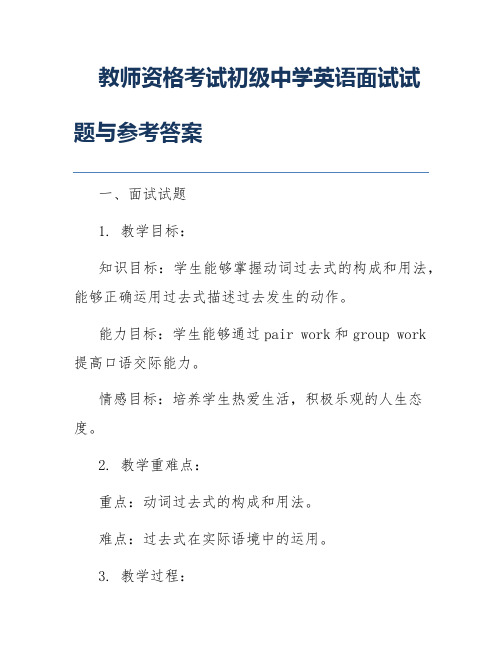
教师资格考试初级中学英语面试试题与参考答案一、面试试题1. 教学目标:知识目标:学生能够掌握动词过去式的构成和用法,能够正确运用过去式描述过去发生的动作。
能力目标:学生能够通过pair work和group work 提高口语交际能力。
情感目标:培养学生热爱生活,积极乐观的人生态度。
2. 教学重难点:重点:动词过去式的构成和用法。
难点:过去式在实际语境中的运用。
3. 教学过程:Step 1:热身(5分钟)老师与学生进行简单的英语对话,询问学生昨天做了什么,引导学生回顾过去式的概念。
Step 2:新课导入(10分钟)老师通过图片展示不同的动词过去式例子,引导学生发现动词过去式的构成规律。
学生分组讨论并总结规律。
Step 3:课堂练习(10分钟)学生分成小组,根据老师提供的场景,用动词过去式编写对话。
老师选取几组对话进行展示和点评。
Step 4:拓展活动(10分钟)学生分成小组,根据老师提供的图片,用动词过去式编写小故事。
老师选取几组故事进行展示和点评。
Step 5:总结与作业布置(5分钟)老师对本节课的内容进行总结,强调动词过去式的用法。
布置作业:用动词过去式写一篇关于昨天经历的短文。
二、参考答案1. 教学目标:知识目标:学生能够掌握动词过去式的构成和用法,能够正确运用过去式描述过去发生的动作。
能力目标:学生能够通过pair work和group work 提高口语交际能力。
情感目标:培养学生热爱生活,积极乐观的人生态度。
2. 教学重难点:重点:动词过去式的构成和用法。
难点:过去式在实际语境中的运用。
3. 教学过程:Step 1:热身(5分钟)老师与学生进行简单的英语对话,询问学生昨天做了什么,引导学生回顾过去式的概念。
例:Teacher: Hi, girls and boys. How was your yesterday?Student: Hi, teacher. Yesterday I played basketball with my friends.Step 2:新课导入(10分钟)老师通过图片展示不同的动词过去式例子,引导学生发现动词过去式的构成规律。
初中英语教师面试题目(3篇)
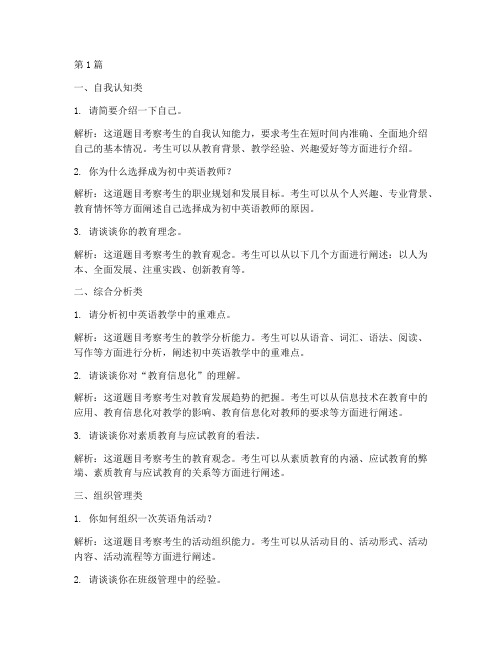
第1篇一、自我认知类1. 请简要介绍一下自己。
解析:这道题目考察考生的自我认知能力,要求考生在短时间内准确、全面地介绍自己的基本情况。
考生可以从教育背景、教学经验、兴趣爱好等方面进行介绍。
2. 你为什么选择成为初中英语教师?解析:这道题目考察考生的职业规划和发展目标。
考生可以从个人兴趣、专业背景、教育情怀等方面阐述自己选择成为初中英语教师的原因。
3. 请谈谈你的教育理念。
解析:这道题目考察考生的教育观念。
考生可以从以下几个方面进行阐述:以人为本、全面发展、注重实践、创新教育等。
二、综合分析类1. 请分析初中英语教学中的重难点。
解析:这道题目考察考生的教学分析能力。
考生可以从语音、词汇、语法、阅读、写作等方面进行分析,阐述初中英语教学中的重难点。
2. 请谈谈你对“教育信息化”的理解。
解析:这道题目考察考生对教育发展趋势的把握。
考生可以从信息技术在教育中的应用、教育信息化对教学的影响、教育信息化对教师的要求等方面进行阐述。
3. 请谈谈你对素质教育与应试教育的看法。
解析:这道题目考察考生的教育观念。
考生可以从素质教育的内涵、应试教育的弊端、素质教育与应试教育的关系等方面进行阐述。
三、组织管理类1. 你如何组织一次英语角活动?解析:这道题目考察考生的活动组织能力。
考生可以从活动目的、活动形式、活动内容、活动流程等方面进行阐述。
2. 请谈谈你在班级管理中的经验。
解析:这道题目考察考生的班级管理能力。
考生可以从班级制度建设、学生行为规范、家校沟通等方面进行阐述。
3. 请谈谈你如何处理学生之间的矛盾?解析:这道题目考察考生的应急应变能力。
考生可以从沟通协调、公正处理、心理疏导等方面进行阐述。
四、人际交往类1. 请谈谈你与同事之间如何相处?解析:这道题目考察考生的人际沟通能力。
考生可以从相互尊重、团结协作、共同进步等方面进行阐述。
2. 请谈谈你如何与学生家长进行沟通?解析:这道题目考察考生的家校沟通能力。
考生可以从倾听家长意见、尊重家长、有效沟通等方面进行阐述。
2024年5月初中英语教师资格证面试真题

2024年5月初中英语教师资格证面试真题语法课01语法教学试讲Dear Isabel,Thank you for your last letter. Here are photos of me and my twin sister Liu Ying. As you can see, in some ways, we look the same and in some ways, we look different. We both have black eyes and black hair, although my hair is shorter than hers. We both like sports, although Liu Ying is more athletic than me. She's more outgoing and I'm quieter. I think, I'm smarter than her. My favorite subjects are physics and chemistry, and her favorite subject is PE. However, we both enjoying going to the parties.Please visit us soon!基本要求:(1)朗读所给材料。
(2)配合教学内容适当板书。
(3)针对材料所给划线部分,设计相应的语法教学活动。
(4)用英文试讲。
(5)试讲时间:10分钟。
02语法教学试讲This afternoon, we went to Ocean Park. It isn't far from the restaurant where we ate lunch. Unfortunately, we got lost. Our taxi driver didn't know understand what we were saying. Luckily, a man who understood Putonghua told the driver where we were going. Ocean Park has a lot of marine, or ocean animals as well as some very exciting rides. Dad and I went on a ride that goes round and round very fast, Afterwards, Mum wanted to go to a market but I was too tired. Dad and I went back to the hotel and Mum went to the market by herself.基本要求:(1)朗读所给材料。
初中英语教师资格证面试真题10(语音)
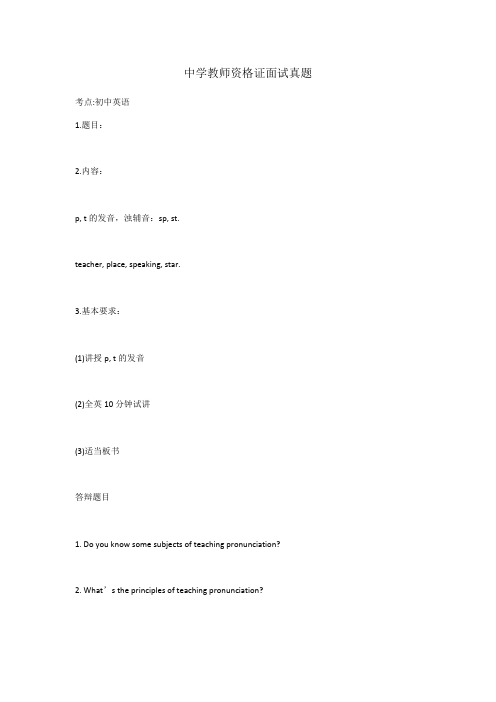
中学教师资格证面试真题考点:初中英语1.题目:2.内容:p, t的发音,浊辅音:sp, st.teacher, place, speaking, star.3.基本要求:(1)讲授p, t的发音(2)全英10分钟试讲(3)适当板书答辩题目1. Do you know some subjects of teaching pronunciation?2. What’s the principles of teaching pronunciation?二、考题解析【教案】Teaching aims:Knowledge aim:Students will master the pronunciation of “p”, “t”,“sp”and “st”.Ability aim:Students will know how to pronounce “p”, “t”,“sp”and “st”in words.Emotional aim:Students can foster the interest and desire of learning English, and be fond of taking part in kinds of class activities.Key and difficult point:Key Point:Students can master the pronunciation of the letters and group of letters.Students will know how to pronounce them in words.Difficult Point:Students can improve their confidence in learning English, and not be afraid of speaking English.Teaching procedure:Step 1: Warming-up1. Greetings. Talk about the weather.2. Show tongue twisters to the students[p] Peter’s plane is plainly painted .Peter is paid plenty to paint planes .[t]Too many teenagers tend to waste their time watching television.Ask them if they can read the tongue twisters as fast as possible. Then they find it not easy to read them fluently and quickly. Later, the teacher can lead in the topic. Today we are going to learn the pronunciation about the letter “p, t”.Step 2: Presentation1. Listen to the recording carefully, and try to find what the listening is about. Meanwhile, circle the words with letter “p”and “t”.2. Listen to the recording for the second time. And try to find rule of the pronunciation of letter “p”and letter “t”, and pay attention to differences of these two letters’pronunciation in the letter group- “sp, st”. They may say that in the words like teacher and play, the letter “p”and “t”are voiceless. However, in the letter groups of “sp”and “st”, they should make a sound . And they pronounce differently.3. Conclude the pronunciation of letter “p”and letter “t”. Tell them that the letter “p”and “t”are voiceless consonant, while in the letter groups of “sp”and “st”, the letter “p”and “t”are voiced consonant.4. Show the pronunciation of these two letters to the students. Ask them to read after the teacher practice.Step 3: Practice1. Play a game named “odd one out”. Read some groups of words for the students. They should listen carefully and say which word is different.For example: sports Spanish stupid spirit2.Ask a few students if there are other words containing the letter “p”, “t”and the letter groups of “sp”and “st”. They may answer “pen, piano,take, talk”, “spell, spring, spirit”, “stand, stay, stop”.3.Play a game named “send words home”. Show others words including the letter “p”, “t”and the letter groups of “sp”and “st”on the screen. Introduce the rule of the game briefly. Then invite some students to the front and write the words down on the blackboard. Check answers later.Step4: ProductionAsk students to make some sentence with the words on the blackboard in groups of 4. After 5 minutes, invite some group members to share their sentences. Give evaluation to them.Step5: Summary and HomeworkSummary: Ask a student to conclude the content of the lesson and summarize with the whole class.Homework: Read the words and the tongue twister to their friends and make more sentences with the target letters.Blackboard design:Pronunciationp:play pot speakingspecialst: teacher toughstarstickvoicelessvoicedpack, pass, pick,tape, tail, team spot,span, spoil staff, stuck,state【答辩题目解析】1. Do you know some subjects of teaching pronunciation?【参考答案】Well, it includes basic pronunciation such as pronunciation of 26 letters, pronunciation of vowels in the stressed syllables, pronunciation of consonant clusters and so on. It also teaches stress of words and sentences. The variation of pronunciations is the important part which deals with liaison, weak form, loss of plosive and assimilation.2. What’s the principles of teaching pronunciation?【参考答案】I think it should focus on the following principles:①Accuracy. It is the primary principle in teaching pronunciation.②Long-tern development. Teaching pronunciation is not just a task for students who have begun to learn, it must run through all stages.③Comprehensiveness. Teaching pronunciation is not teaching isolated speech sounds. All aspects should be included such as phonemes, phonetic symbols, words , sentences, meaning and uses.。
(完整word版)初中英语教师资格证面试真题(2016-2018)
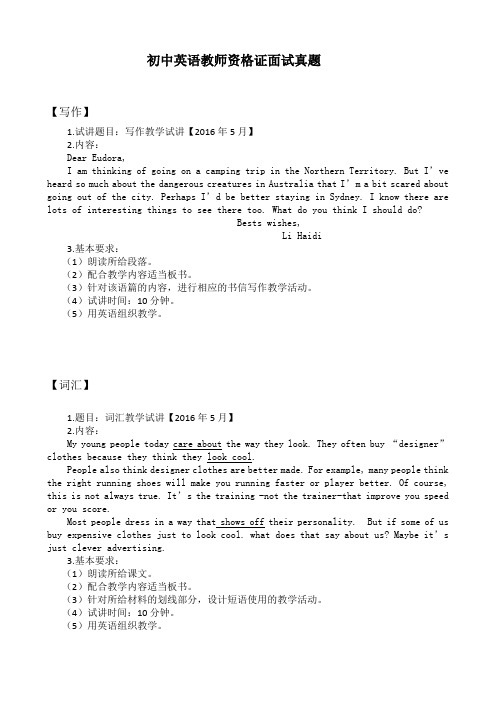
初中英语教师资格证面试真题【写作】1.试讲题目:写作教学试讲【2016年5月】2.内容:Dear Eudora,I am thinking of going on a camping trip in the Northern Territory. But I’ve heard so much about the dangerous creatures in Australia that I’m a bit scared about going out of the city. Perhaps I’d be better staying in Sydney. I know there are lots of interesting things to see there too. What do you think I should do?Bests wishes,Li Haidi3.基本要求:(1)朗读所给段落。
(2)配合教学内容适当板书。
(3)针对该语篇的内容,进行相应的书信写作教学活动。
(4)试讲时间:10分钟。
(5)用英语组织教学。
【词汇】1.题目:词汇教学试讲【2016年5月】2.内容:My young people today care about the way they look. They often buy “designer”clothes because they think they look cool.People also think designer clothes are better made. For example, many people think the right running shoes will make you running faster or player better. Of course, this is not always true. It’s the training -not the trainer-that improve you speed or you score.Most people dress in a way that shows off their personality. But if some of us buy expensive clothes just to look cool. what does that say about us? Maybe it’s just clever advertising.3.基本要求:(1)朗读所给课文。
教师资格证初中英语面试真题集
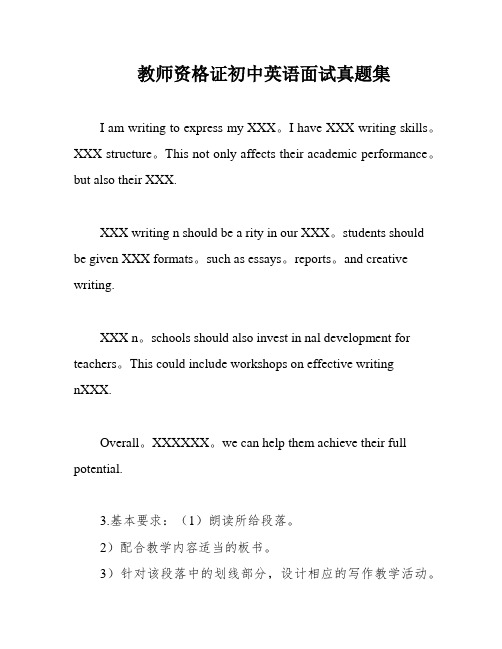
教师资格证初中英语面试真题集I am writing to express my XXX。
I have XXX writing skills。
XXX structure。
This not only affects their academic performance。
but also their XXX.XXX writing n should be a rity in our XXX。
students should be given XXX formats。
such as essays。
reports。
and creative writing.XXX n。
schools should also invest in nal development for teachers。
This could include workshops on effective writing nXXX.Overall。
XXXXXX。
we can help them achieve their full potential.3.基本要求:(1)朗读所给段落。
2)配合教学内容适当的板书。
3)针对该段落中的划线部分,设计相应的写作教学活动。
4)试讲时间:约10分钟。
5)用英文试讲。
Possible revised n:Dear Editor。
I am writing to express my XXX。
I have XXX writing skills。
XXX structure。
This not only affects their academic performance。
but also their XXX.To address this issue。
I propose a series of writing workshops for both teachers and students。
These workshopswould cover us aspects of writing。
初中英语教师资格证面试题

初中英语汇总一、1.题目: The Science Museum in London2.内容:In most museums, there is no shouting and no running, and you must not touch anything. But the Science Museum is different. It is noisy! People talk about what they can see and do here and there are some very noisy machines as well .If you want answers to allyour questions about science, this is the right place for you.The Launchpad on the third floor is the most popular room.Because there are lots of physics experiments. For example, if you want to fill a bag with sand, you have to control a kind of truck on heels and move it into the correct place.On the fourth and fifth floors, you can learn about what medicine was like in the past. If you compare the medicine of the past with the medicine of today, you will feel very lucky next time you visita doctor!3.基本要求:(1) 讲解if状语从句;(2) 朗读一遍;(3) 全英试讲,讲解10分钟。
初中英语教师资格证面试2023年12月面试真题

初中英语教师资格证面试2023年12月面试真题阅读课01阅读教学试讲Dear friend,I know you are arriving next Sunday.Let me tell you the way to my house.Take a taxi from the airport.You pass a bank on your right and then go down Long Street.You go through Sixth Avenue,Seventh Avenue,and Eighth Avenue.When you see a big supermarket,turn left.Then go down Bridge Street and turn left at New Park.Go down Center Street and my house is on your right.基本要求:(1)朗读所给材料。
(2)配合教学内容适当板书。
(3)针对材料所给内容,设计相关阅读教学活动。
(4)用英文试讲。
(5)试讲时间:10分钟。
02阅读教学试讲The Encyclopaedia Britannica is a world-famous encyclopedia.It is the oldest English-language encyclopedia.The first edition was published in1768,and since then there have been15editions.The15thedition is made up Enoclopodia Britannicaof32volumes.Together they contain about40million words on half a million topics. The15th edition was the last printed edition,Today you can find the Britannica online.基本要求:(1)朗读所给材料。
初中英语教师资格证面试真题

初中英语教师资格证面试真题I will divide the class into small groups and give them a taskto discuss: “What do you think are the advantages and disadvantages of XXX in the article?” After they finish the n。
Iwill ask some groups to share their ideas with the whole class.Step 5 n:I will ask the students to write a short paragraph about what they want to be when they grow up and why。
Then。
I will ask some students to read their paragraphs aloud in front of the class.In this lesson。
we will talk about the topic of career choices。
We will start by listening to a song called “Be What You Wanna Be” and discuss the XXX。
Then。
we will focus on the article about career choices and discuss XXX。
students will have the XXX.To warm up。
we will listen to a song called “Be What YouW anna Be” and discuss the XXX。
After that。
I will ask studentswhat they want to be when they grow up and lead into today’s topic。
- 1、下载文档前请自行甄别文档内容的完整性,平台不提供额外的编辑、内容补充、找答案等附加服务。
- 2、"仅部分预览"的文档,不可在线预览部分如存在完整性等问题,可反馈申请退款(可完整预览的文档不适用该条件!)。
- 3、如文档侵犯您的权益,请联系客服反馈,我们会尽快为您处理(人工客服工作时间:9:00-18:30)。
1.试讲题目:阅读教学试讲
2.内容:
Class 9 had a great time on the school trip. They went to Blue Water Aquarium for the day. First they visited the visitors center and watched about sharks. Then they watched a dolphin show. After that, they went to the outdoor Pool and saw a big octopus. After lunch, they went to the Gift Shop and bought lots of gifts. Finally, tired but happy, they took the bus back to school. At the end of the day, the science teacher was very happy because the class monitor cleaned the bus after the trip.
3. 基本要求:(1)朗读所给段落。
(2)配合教学内容适当的板书。
(3)针对该段落中的划线部分,设计相应的阅读后教学活动。
(4)试讲时间:约10分钟。
(5)用英文试讲。
1.写作教学试讲
2.内容:
Dear Editor,
I am writing to say that I am against building a new zoo in our town. Zoos are terrible places for animals to live. I’ve visited a lot of zoos in my
life, and I have never seen one I liked or one that was suitable for animals to live in. Just last week, I visited a zoo and couldn’t believe what I saw. The animals are kept in tiny cages and can hardly move at all. And they are only given food once a day. Is this a good way for animals to live? I don’t think so.
Sincerely,
Disgusted 3 基本要求:
(1)朗读所给短信。
(2)配合教学内容适当的板书。
(3)针对该短信的体裁与结构特征,设计相应的书信写作教学活动。
(4)试讲时间:约10分钟。
(5)用英文试讲。
1.试讲题目:词汇讲学试讲
2.内容:
在初中七年级下学期期末复习时,周老师希望帮助学生巩固以下的词汇;
Soccer, strawberry, hamburgers, baseball, enjoy, difficult, boring, uncle, practice
3.基本要求:
(1)朗读所给单词。
(2)配合教学内容适当的板书。
(3)针对所提供的词汇,设计词汇巩固性教学活动。
(4)试讲时间:约10分钟。
(5)用英文试讲。
1.试讲题目:阅读教学试讲
2.内容:
One day, a man called the taxi company to get a taxi to go to the airport, but after a very long time, the taxi did not come. He called the girl in the taxi company again. The girl in the taxi company said, “ the taxi has not come, but you need not to worry about it as the airplane is always late.” the man answered, “certainly, the airplane will be late this morning, because I happen to be flying it.”
3.基本要求:(1)朗读所给段落。
(2)配合教学内容适当的板书。
(3)针对该段落中的划线部分,设计相应的阅读后教学活动。
(4)试讲时间:约10分钟。
(5)用英文试讲。
